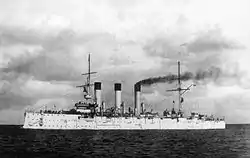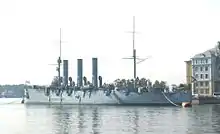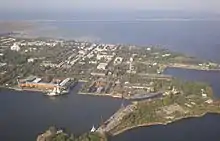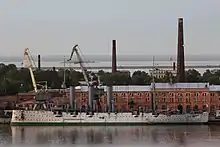Russian cruiser Aurora
Aurora (Russian: Авро́ра, tr. Avrora, IPA: [ɐˈvrorə]) is a 1900 Russian protected cruiser, currently preserved as a museum ship in Saint Petersburg. Aurora was one of three Pallada-class cruisers, built in Saint Petersburg for service in the Pacific. All three ships of this class served during the Russo-Japanese War. Aurora survived the Battle of Tsushima and was interned under US protection in the Philippines, and eventually returned to the Baltic Fleet.
 Aurora, moored in Saint Petersburg, Russia | |
| History | |
|---|---|
Russian Empire → Soviet Russia → Russia | |
| Name: | Aurora |
| Namesake: | Aurora |
| Ordered: | June 1896 |
| Builder: | Admiralty Shipyard, Saint Petersburg |
| Laid down: | 23 May 1897 |
| Launched: | 11 May 1900[1] |
| Completed: | 10 July 1903 |
| Commissioned: | 16 July 1903 |
| Decommissioned: | 17 November 1948 |
| Honours and awards: | |
| Fate: | Museum ship since 1956 |
| Status: | Ceremoniously commissioned |
| Notes: |
|
| General characteristics | |
| Class and type: | Pallada-class protected cruiser |
| Displacement: | 6,731 t (6,625 long tons) |
| Length: | 126.8 m (416 ft 0 in) |
| Beam: | 16.8 m (55 ft 1 in) |
| Draught: | 7.3 m (23 ft 11 in) |
| Installed power: |
|
| Propulsion: | 3 shafts; 3 triple-expansion steam engines |
| Speed: | 19 knots (35 km/h; 22 mph) |
| Range: | 7,200 km (4,500 mi) at 10 knots (19 km/h; 12 mph) |
| Complement: | 590[1] |
| Armament: |
|
The second ship, Pallada, was sunk by the Japanese at Port Arthur in 1904. The third ship, Diana, was interned in Saigon after the Battle of the Yellow Sea. One of the first incidents of the October Revolution in Russia took place on the cruiser Aurora, which reportedly fired the first shot, signalling the beginning of the attack on the Winter Palace.
Russo-Japanese War

Soon after completion, on October 10, 1903, Aurora departed Kronstadt as part of Admiral Virenius's "reinforcing squadron" for Port Arthur.[3] While in the Red Sea, still enroute to Port Arthur, the squadron was recalled back to the Baltic Sea, under protest by Admiral Makarov, who specifically requested Admiral Virenius to continue his mission to Port Arthur. Only the 7 destroyers of the reinforcing squadron were allowed to continue to the Far East.[4]
After her detachment from the reinforcing squadron and her arrival back to home port she underwent new refitting.[5] After refitting, Aurora was ordered back to Port Arthur as part of the Russian Baltic Fleet[6][7] Aurora sailed as part of Admiral Oskar Enkvist's Cruiser Squadron whose flagship would be the Protected Cruiser Oleg, an element of Admiral Zinovy Rozhestvensky's Baltic Fleet.[8] On the way to the Far East, Aurora received 5 hits, sustaining light damage from confused friendly fire, which killed the ship's chaplain and a sailor, in the Dogger Bank incident.[9]
On 27 and 28 May 1905 Aurora took part in the Battle of Tsushima, along with the rest of the Russian squadron. During the battle her captain, Captain 1st rank Eugene R. Yegoryev, and 14 crewmen were killed. The executive officer, Captain of 2nd rank Arkadiy Konstantinovich Nebolsine, took command although wounded. After that Aurora, covering other much slower Russian vessels, became the flagship of Rear-Admiral Enkvist, and with two other Russian cruisers broke through to neutral Manila, where she was interned by United States authorities from 6 June 1905 until the end of the war.
In 1906 Aurora returned to the Baltic and became a cadet training ship. From 1906 until 1912 the cruiser visited a number of other countries; in November 1911 she was in Bangkok as part of the celebrations in honour of the coronation of the new King of Siam.
October Revolution mutiny
.jpg.webp)
During World War I Aurora operated in the Baltic Sea performing patrols and shore bombardment tasks. In 1915, her armament was changed to fourteen 152 mm (6 in) guns. At the end of 1916, she was moved to Petrograd (the renamed Saint Petersburg) for a major repair. The city was brimming with revolutionary ferment and part of her crew joined the 1917 February Revolution.
The ship's commanding officer, Captain Mikhail Nikolsky, was killed when he tried to suppress the revolt.[10] A revolutionary committee was created on the ship, with Aleksandr Belyshev elected as captain. Most of the crew joined the Bolsheviks, who were preparing for a Communist revolution.
At 9.40pm on 24 October 1917 (Old Style; 6 November New Style) a blank shot from her forecastle gun signaled the start of the assault on the Winter Palace, which was to be the beginning of the October Revolution. In summer 1918, she was relocated to Kronstadt and placed into reserve.
Second World War

In 1922 Aurora returned to service as a training ship. Assigned to the Baltic Fleet, from 1923, she repeatedly visited the Baltic Sea countries, including Norway in 1924, 1925, 1928 and 1930, Germany in 1929 and Sweden in 1925 and 1928. On 2 November 1927, Aurora was awarded the Order of the Red Banner for her revolutionary merits.
During the Second World War, the guns were taken from the ship and used in the land defence of Leningrad. The ship herself was docked in Oranienbaum port,[11] and was repeatedly shelled and bombed. On 30 September 1941 she was damaged and sunk in the harbour.
In 1944 despite the vessel's state, Aurora became the first campus and training vessel of the Nakhimov Naval School.
After extensive repairs from 1945 to 1947, Aurora was permanently anchored on the Neva in Leningrad (now St. Petersburg again) as a monument to the Great October Socialist Revolution. In 1957 she became a museum-ship. On 22 February 1968 she was awarded the Order of the October Revolution, whose badge portrays Aurora herself.
To the present


As a museum ship, the cruiser Aurora became one of the many tourist attractions of Leningrad (now Saint Petersburg), and continued to be a symbol of the October Socialist Revolution and a prominent attribute of Russian history. In addition to the museum space, a part of the ship continued to house a naval crew whose duties included caring for the ship, providing security and participating in government and military ceremonies. The crew was considered to be on active duty and was subject to military training and laws.
.svg.png.webp)
Having long served as a museum ship, from 1984 to 1987 the cruiser was once again placed in her construction yard, the Admiralty Shipyard, for capital restoration. During the overhaul, due to deterioration, the ship's hull below the waterline was replaced with a new welded hull according to the original drawings. The cut off lower hull section was towed into the Gulf of Finland, to the unfinished base at Ruchi, and sunk near the shore. The restoration revealed that some of the ship parts, including the armour plates, were originally made in Britain.
Aurora is the oldest commissioned ship of the Russian Navy, still flying the naval ensign under which she was commissioned, but now under the care of the Central Naval Museum. She is still manned by an active service crew commanded by a Captain of the 1st Rank.
In January 2013 Russian Defence Minister Sergey Shoygu announced plans to recommission Aurora and make her the flagship of the Russian Navy due to her historical and cultural importance.[12] On 21 September 2014 the ship was towed to the Admiralty Shipyard in Kronstadt to be overhauled,[13][14] to return in 2016.[15] On 16 July 2016 she returned to her home harbour in Saint Petersburg.[16]

See also
- Japanese battleship Mikasa, the other surviving warship of the Battle of Tsushima
- The Twelfth Symphony by Dmitri Shostakovich (title of 3rd movement)
Footnotes
- "Official Cruiser Aurora website". Archived from the original on 2 October 2009. Retrieved 24 March 2014.
- Поленов Л. Л. Крейсер «Аврора» — с. 162—165
- Corbett (2015) Vol. 1, p. 51
- Corbett (2015) Vol. 1, p. 146, 147
- Kowner, Rotem (2006). Historical Dictionary of the Russo-Japanese War. The Scarecrow Press. p. 52. ISBN 0-8108-4927-5.
- Corbett (2015) Vol. 2, Chapters I, VI, X, XI, XIII, XIV
- British Naval Attache Reports (2003) p. 354 the new redesignation to the 2nd Pacific Squadron was rarely used, in both Corbett texts and official British Naval Attache Reports, the term Balic Fleet is mostly consistent.
- Corbett (2015) Vol. 2, p. 194, 215, 273
- Corbett (2015) Vol. 2, p. 35
- Dowling, p. 571
- Sávina, Sofía (7 November 2014). "Aurora: The cruiser that sparked a revolution – or did it?".
- http://2-news.ru/info/politics/211-avrora_vernetsya_v_stroy_.html%5B%5D
- "Aurora: The cruiser that sparked a revolution – or did it?".
- RT (21 September 2014). "Russian Revolution Symbol: Iconic 'Aurora' cruiser towed to renovation port" – via YouTube.
- "Legendary Aurora to return to its harbour after overhaul in 2016". ITAR-TASS. 13 October 2014.
- https://www.heraldnet.com/news/bolshevik-revolution-warship-aurora-returns-to-st-petersburg/
Sources
- British Naval Attache Reports. (2003) The Russo-Japanese War 1904-1905. The Battery Press, Inc. Nashville, TN ISBN 0-89839-324-8
- Corbett, Sir Julian. (2015) Maritime Operations In The Russo-Japanese War 1904-1905. Vol. 1 originally published Jan 1914. Naval Institute Press ISBN 978-1-59114-197-6
- Corbett, Sir Julian. (2015) Maritime Operations In The Russo-Japanese War 1904-1905. Vol. 2 originally published Oct 1915. Naval Institute Press ISBN 978-1-59114-198-3
- Timothy C. Dowling. Russia at War: From the Mongol Conquest to Afghanistan, Chechnya, and Beyond. ABC-CLIO, 2015. ISBN 978-1-59884-947-9
- McLaughlin, Stephen (2019). "In Avrora's Shadow: The Russian Cruisers of the Diana Class". In Jordan, John (ed.). Warship 2019. Oxford, UK: Osprey Publishing. pp. 81–97. ISBN 978-1-4728-3595-6.
- Skvorcov, Aleksiey V. (2015). Cruisers of the First Rank: Avrora, Diana, Pallada. Sandomierz, Poland: Stratus. ISBN 978-83-63678-56-2.
- Watts, Anthony J. (1990). The Imperial Russian Navy. London: Arms and Armour. ISBN 0-85368-912-1.
External links
| Wikimedia Commons has media related to Aurora (ship, 1900). |
- Official website (in English and Russian)
- The History of the Russian Navy - Defeat at Port Arthur
- HNSA Web Page: Cruiser Aurora
- Aurora Cruiser Museum Ship (Saint Petersburg)